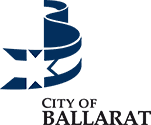
Back Ballarat North CEB Ballarat City German Ville de Ballarat French Città di Ballarat Italian Ballarat City Dutch City of Ballarat Polish City of Ballarat Swedish
| City of Ballarat Victoria | |||||||||||||||
|---|---|---|---|---|---|---|---|---|---|---|---|---|---|---|---|
 Map of the City of Ballarat's municipal borders, urban areas and location in Victoria | |||||||||||||||
| Population | 107,325 (2018)[1] | ||||||||||||||
| • Density | 145.23/km2 (376.14/sq mi) | ||||||||||||||
| Established | 6 May 1994 | ||||||||||||||
| Gazetted | 6 May 1994[2] | ||||||||||||||
| Area | 739 km2 (285.3 sq mi)[1] | ||||||||||||||
| Mayor | Cr Des Hudson | ||||||||||||||
| Council seat | Central | ||||||||||||||
| Region | Grampians | ||||||||||||||
| State electorate(s) | |||||||||||||||
| Federal division(s) | Ballarat | ||||||||||||||
 | |||||||||||||||
| Website | City of Ballarat | ||||||||||||||
| |||||||||||||||
The City of Ballarat is a local government area in the west of the state of Victoria, Australia. It covers an area of 739 square kilometres (285 sq mi) and, in June 2018, had a population of 107,325.[1] It is primarily urban with the vast majority of its population living in the Greater Ballarat urban area, while other significant settlements within the LGA include Buninyong, Waubra, Learmonth and Addington. It was formed on 6 May 1994 from the amalgamation of the City of Ballarat, Shire of Ballarat, Borough of Sebastopol and parts of the Shire of Bungaree, Shire of Buninyong, Shire of Grenville and Shire of Ripon.[2]
The City is governed and administered by the Ballarat City Council; its seat of local government and administrative centre is located at the council headquarters in Ballarat, it also has a service centre located in Buninyong. The City is named after the main urban settlement lying in the centre-south of the LGA, Ballarat, which is also the LGA's most populous urban area with a population of 105,471.[3]
- ^ a b c "3218.0 – Regional Population Growth, Australia, 2017-18: Population Estimates by Local Government Area (ASGS 2018), 2017 to 2018". Australian Bureau of Statistics. Australian Bureau of Statistics. 27 March 2019. Retrieved 25 October 2019. Estimated resident population, 30 June 2018.
- ^ a b "Order Constituting the City of Ballarat..." Victoria Government Gazette (S23). State Government of Victoria: 1. 6 May 1994. Retrieved 10 January 2014.
- ^ "3218.0 – Regional Population Growth, Australia, 2017-18: Population Estimates by Significant Urban Area, 2008 to 2018". Australian Bureau of Statistics. Australian Bureau of Statistics. 27 March 2019. Retrieved 25 October 2019. Estimated resident population, 30 June 2018.
© MMXXIII Rich X Search. We shall prevail. All rights reserved. Rich X Search